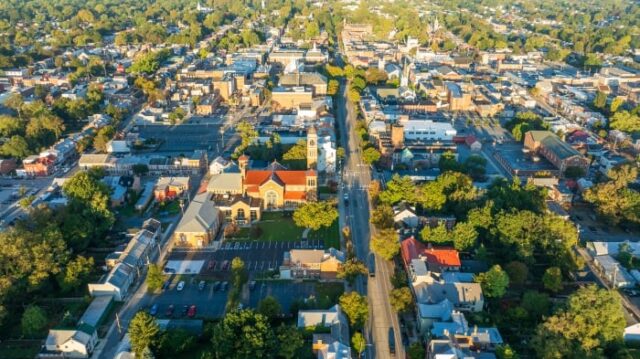Most investors crowd into the same handful of “hot” cities. Austin, Nashville, Miami, Phoenix, chasing headlines and hoping the trend continues forever. But the best opportunities often live off the radar, in smaller markets that haven’t hit investors’ radar yet.
After 30 years and 10,000+ units, I’ve learned that growth doesn’t always start in big metros. It starts quietly. In college towns, logistics corridors, and forgotten communities with strong fundamentals and low barriers to entry.
Today, I want to share five markets and regions that are underrated and ready for long-term growth.
1. Shippensburg, Pennsylvania – Central PA’s Quiet Workhorse
Most people overlook Central Pennsylvania, but that’s a mistake. Shippensburg and its surrounding counties (Cumberland and Franklin) have strong fundamentals: affordable housing, a major state university, and a growing distribution and logistics sector.
This region sits right between Harrisburg and Hagerstown, meaning it benefits from the East Coast shipping corridor but without the inflated prices. The workforce is stable, the community is tight-knit, and the town is starting to see slow but steady revitalization.
Why I like it:
-
Home to Shippensburg University (anchors rental demand)
-
Access to I-81 and major trucking routes
-
Solid local employers in health care and logistics
-
Low housing costs and pro-growth zoning policies
It’s the kind of place that doesn’t make headlines — but quietly compounds over time.

2. Rust Belt Revival – Small-Town Ohio, West Virginia, and Kentucky
The “Rust Belt” label hides a lot of opportunity. Many of these towns already have great infrastructure, skilled labor, and proximity to major metros, but they’ve been overlooked for decades.
What’s changing now is remote work and manufacturing reshoring. As new industries expand across the Midwest, small cities like Lima (Ohio), Wheeling (West Virginia), and Ashland (Kentucky) are beginning to re-emerge.
Why I like it:
-
Low entry costs and solid rental yields
-
Workforce hungry for new opportunity
-
Potential for value-add housing and small-business revitalization
Investors who can work hand-in-hand with local municipalities are finding real tailwinds here.
3. The Southern Sleepers – Huntsville, Chattanooga, and Greenville
When people think of the South, they think Atlanta, Dallas, or Nashville. But second-tier metros like Huntsville, Alabama, Chattanooga, Tennessee, and Greenville, South Carolina are outperforming in population growth and affordability.
These cities offer a perfect mix of business-friendly policy, expanding tech and manufacturing hubs, and strong in-migration from higher-cost states.
Why I like it:
-
Fastest-growing workforces in the region
-
Affordable entry points for multifamily and build-to-rent
-
Strong universities and industry anchors (like BMW in Greenville and NASA in Huntsville)
They’re also big enough to have urban amenities, but small enough to keep cash-flow positive investments realistic.
4. Exurban Growth Rings – Beyond the Sun Belt Metros
Everyone knows Phoenix, Dallas, and Tampa are hot. But the real value today might be just outside those metros, in exurban towns with room to grow.
Look at places like Casa Grande, Arizona, Georgetown, Texas, and Ocala, Florida. These areas are far enough to offer affordability, but close enough to benefit from major job centers.
Why I like it:
-
Migration from city cores is pushing demand outward
-
Infrastructure and retail amenities are playing catch-up
-
Strong long-term potential for residential and commercial infill
This is the same pattern I saw 20 years ago in Phoenix’s outer suburbs, and it’s happening again.
5. Small-Town Tourism & Heritage Markets
Finally, don’t underestimate America’s small-town tourism corridor. Places with charm, history, or outdoor access that haven’t yet built the right infrastructure to capture visitors.
Towns like Lanesboro, Minnesota, Hood River, Oregon, and Hudson, New York have turned their local heritage into thriving micro-economies. Many others from Iowa’s river towns to inland Maine are still waiting for someone to connect the dots.
Why I like it:
-
Low barriers to entry for short-term rentals and boutique lodging
-
Community support for revitalization
-
Strong long-term appeal as domestic travel grows
The right mix of authenticity and investment can turn these towns into sustainable cash-flow hubs.
Why Hidden Gem Markets Make Sense Now
-
Lower competition: Fewer institutional investors mean better deals and more direct negotiation.
-
Lower risk: Cheaper land, labor, and taxes provide a cushion against downturns.
-
Rising infrastructure investment: Federal and state funding for broadband, housing, and rural revitalization is flowing into these areas.
-
Cultural shift toward authenticity: People want local, walkable, community-driven experiences, not just another chain development.
In other words, the next wave of growth may not happen in the places everyone’s talking about. It’ll happen in the ones they’re not.
Final Thoughts
When I started investing, I didn’t have access to fancy data or national rankings. I drove neighborhoods, talked to locals, and trusted what I saw. That’s still the formula today.
Don’t just chase the headlines. Go find the quiet towns with solid jobs, good schools, and leaders who want growth. That’s where you’ll find the next generation of opportunity.



